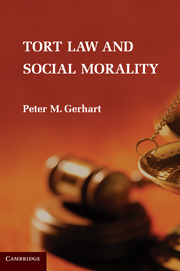Book contents
- Frontmatter
- Contents
- Preface
- Acknowledgments
- PART I OTHER-REGARDING BEHAVIOR
- PART II THE NORMATIVE JUSTIFICATION
- PART III THE THEORY APPLIED
- 6 Social Cohesion and Autonomy: The Justificational Boundary of Duty
- 7 Social Cohesion and Moral Agency: The Justification for Proximate Cause
- 8 Social Cohesion and Strict Liability
- 9 Using Another's Property
- 10 Product Liability: Social Cohesion and Agency Relationships
- 11 Customer-Centered Enterprise Liability
- 12 Social Cohesion and Knowledge: The Intentional Torts
- PART IV SUMMARY AND IMPLICATIONS
- Index
8 - Social Cohesion and Strict Liability
Published online by Cambridge University Press: 04 August 2010
- Frontmatter
- Contents
- Preface
- Acknowledgments
- PART I OTHER-REGARDING BEHAVIOR
- PART II THE NORMATIVE JUSTIFICATION
- PART III THE THEORY APPLIED
- 6 Social Cohesion and Autonomy: The Justificational Boundary of Duty
- 7 Social Cohesion and Moral Agency: The Justification for Proximate Cause
- 8 Social Cohesion and Strict Liability
- 9 Using Another's Property
- 10 Product Liability: Social Cohesion and Agency Relationships
- 11 Customer-Centered Enterprise Liability
- 12 Social Cohesion and Knowledge: The Intentional Torts
- PART IV SUMMARY AND IMPLICATIONS
- Index
Summary
Although tort law centers on the negligence concept, it is accepted that “pockets” of strict liability provide an alternative to the negligence regime. This belief is fueled by cases in which responsibility for the well-being of others appears to be based on causing harm rather than on committing a wrong that causes harm, and by the proliferation of definitions of “strict liability” to cover situations in which “fault” is thought to be absent. Accordingly, tort theory not only assesses the relative merits of strict liability and negligence liability, it seeks to justify their simultaneous implementation within tort law. In this chapter, I question the success of this venture as it applies to abnormally dangerous activities, and I offer a new interpretation. Strict liability of the kind addressed in this chapter puts the focus on an actor's activity. It makes the defendant responsible for causing harm and thereby induces an actor either to set aside money for victims or, if it is cheaper, to make better choices when engaging in the activity that is subject to strict liability.
Undoubtedly, a system of strict liability applied to all accidental harms, although not without its problems, could be made coherent. Causing harm could be seen as a basis for compelling an actor to correct the harm she caused, whatever the context, with appropriate adjustments for victim error and an appropriate definition of “cause.
- Type
- Chapter
- Information
- Tort Law and Social Morality , pp. 150 - 178Publisher: Cambridge University PressPrint publication year: 2010
- 1
- Cited by



